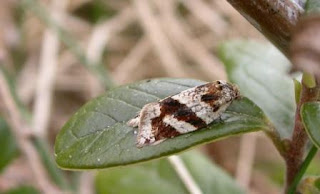 Having read about Larch Case-bearer (Coleophora laricella) on Charlie Streets' blog I decided to go and find some for myself. I explored the woodland on Otley Chevin until I located a couple of European Larch (Larix decidua)trees with branches close enough to the ground to be accessible. It didn't take long to find larval cases of Coleophora laricella.
Having read about Larch Case-bearer (Coleophora laricella) on Charlie Streets' blog I decided to go and find some for myself. I explored the woodland on Otley Chevin until I located a couple of European Larch (Larix decidua)trees with branches close enough to the ground to be accessible. It didn't take long to find larval cases of Coleophora laricella.The Larch is a native of central and east European mountains and was not introduced to Britain until circa 1629.................when John Milton was alive.


















